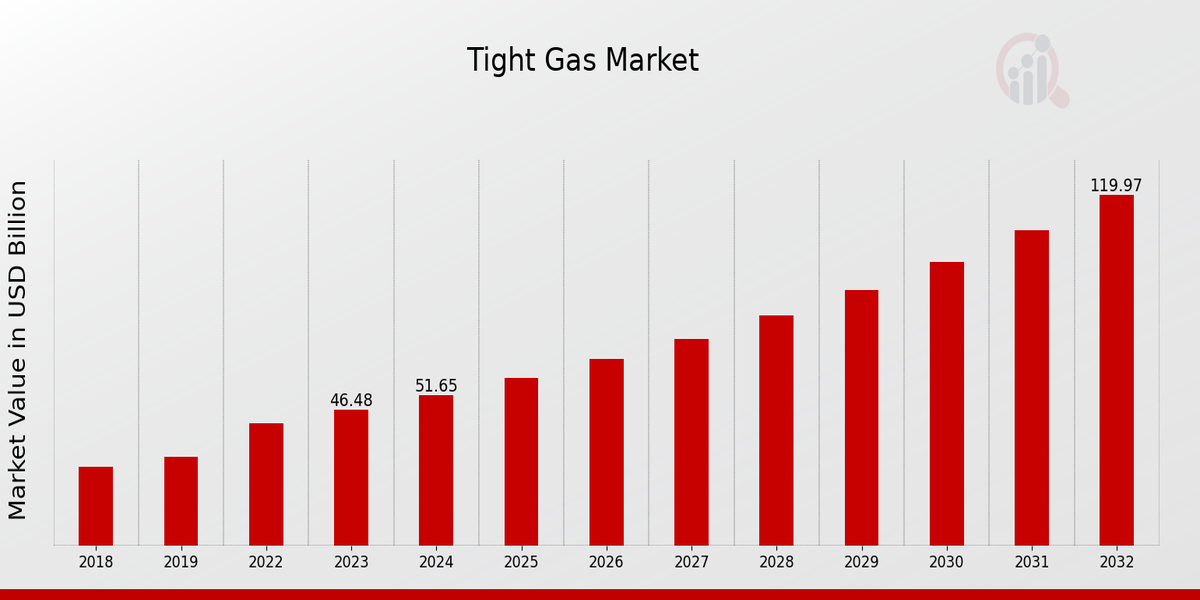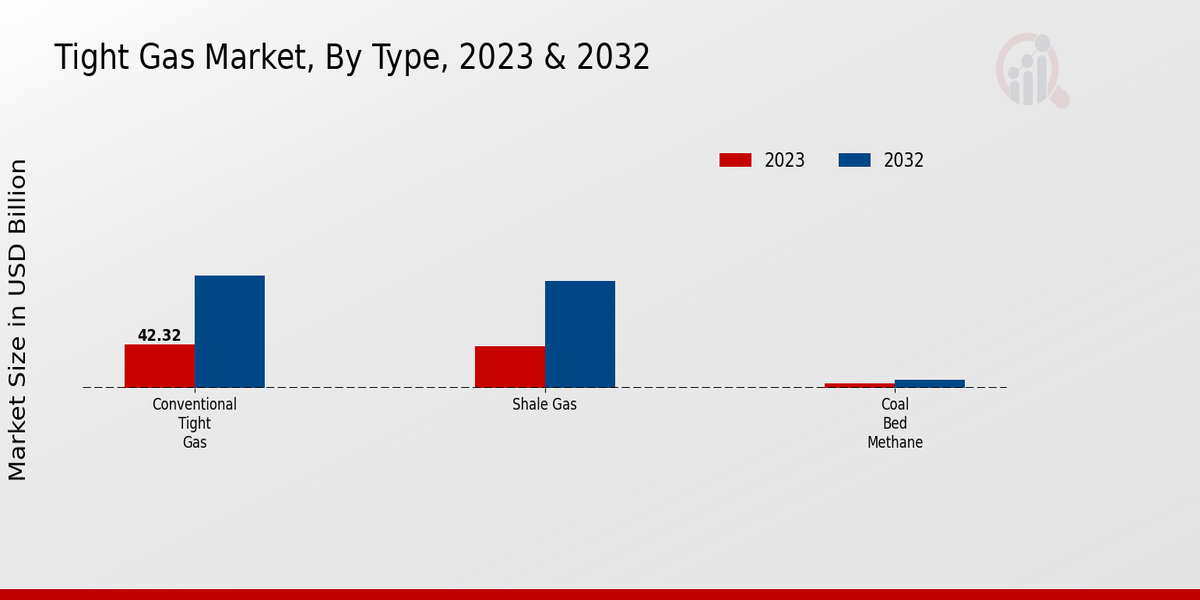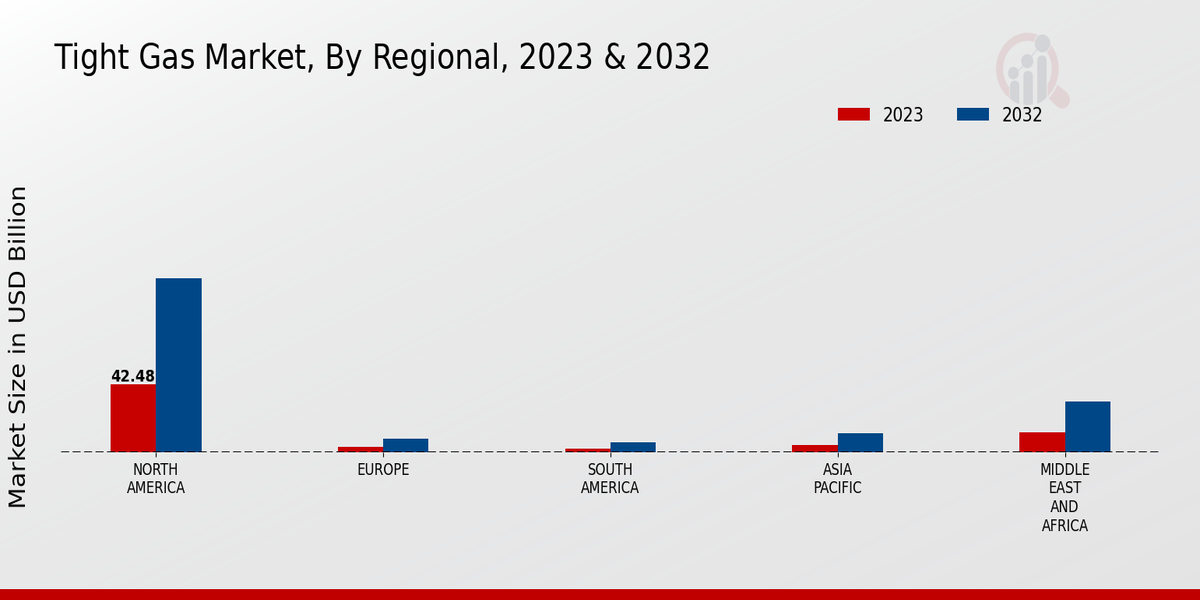Tight Gas Market Overview
As per MRFR analysis, the Tight Gas Market Size was estimated at 57.40 (USD Billion) in 2024. The Tight Gas Market Industry is expected to grow from 63.77 (USD Billion) in 2025 to 164.62 (USD Billion) till 2034, at a CAGR (growth rate) is expected to be around 11.11% during the forecast period (2025 - 2034).
Key Tight Gas Market Trends Highlighted
Technological advancements, such as horizontal drilling and hydraulic fracturing, have revitalized the tight gas market, allowing for the extraction of significant gas reserves from unconventional sources. The growing demand for cleaner energy sources, particularly natural gas, and the depletion of conventional gas reserves drive market expansion.Key opportunities lie in the development of cost-effective technologies for gas extraction and the exploration of new tight gas formations. Recent trends include the increasing adoption of hybrid drilling techniques, the integration of digital technologies to optimize production, and the implementation of carbon capture and storage systems to reduce the environmental impact. The tight gas market also presents significant challenges, including the high cost of extraction, environmental concerns, and regulatory limitations.
Innovation in drilling and hydraulic fracturing techniques, coupled with the development of more efficient production technologies, will shape the future of the tight gas market. Collaboration between industry players, governments, and research institutions is crucial to address sustainability concerns and ensure the long-term viability of tight gas as a reliable energy source.

Source: Primary Research, Secondary Research, MRFR Database and Analyst Review
Tight Gas Market Drivers
Rising Energy Demand
The increasing global population and economic growth are driving up energy demand, particularly in developing countries. Tight gas is a relatively clean and abundant source of energy that can help meet this demand. It is estimated that the Tight Gas Market will grow at a CAGR of 11.11% from 2023 to 2032, reaching a valuation of USD 120.0 billion by 2032. Tight gas is found in low-permeability rock formations, which makes it more difficult and expensive to extract than conventional gas.However, advances in drilling and completion technologies have made it more economical to produce tight gas. As a result, tight gas is becoming an increasingly important source of energy around the world. The rising demand for energy is expected to be a major driver of growth in the Tight Gas Market. The International Energy Agency (IEA) estimates that global energy demand will increase by 25% between 2023 and 2040. This growth will be driven by increasing population and economic growth, particularly in developing countries.Tight gas is expected to play a significant role in meeting this demand, as it is a relatively clean and abundant source of energy. In addition to rising energy demand, the Tight Gas Market is also being driven by government policies. Many governments are providing incentives to encourage the development of tight gas resources. For example, the US government provides tax credits for the production of tight gas. These incentives are helping to make tight gas more competitive with other sources of energy.
Technological Advancements
Advancements in drilling and completion technologies have made it more economical to produce tight gas. Directional drilling and horizontal drilling techniques allow producers to access tight gas formations that were previously unreachable. Multi-stage fracturing techniques can be used to create multiple fractures in the rock formation, which improves the flow of gas. These technological advancements have significantly reduced the cost of producing tight gas, making it a more viable source of energy. The Tight Gas Market Industry is expected to witness continued growth in the coming years, driven by rising energy demand and technological advancements. The development of new technologies, such as coiled tubing drilling and downhole tractors, is expected to further reduce the cost of producing tight gas. This will make tight gas even more competitive with other sources of energy and help to drive growth in the Tight Gas Market.
Environmental Concerns
Tight gas is a relatively clean source of energy compared to other fossil fuels. It produces lower emissions of greenhouse gases and air pollutants than coal or oil. As a result, tight gas is increasingly being seen as a more environmentally friendly option for meeting global energy demand. Governments around the world are implementing policies to reduce greenhouse gas emissions and improve air quality. These policies are creating a favorable environment for the development of tight gas resources.For example, the European Union has set a target of reducing greenhouse gas emissions by 40% by 2030. This target is driving investment in renewable energy sources, as well as in cleaner fossil fuels such as tight gas. The growing awareness of environmental concerns is expected to be a major driver of growth in the Tight Gas Market. Tight gas is a relatively clean source of energy that can help to reduce greenhouse gas emissions and improve air quality.As a result, tight gas is expected to play an increasingly important role in the global energy mix in the coming years.
Tight Gas Market Segment Insights
Tight Gas Market Type Insights
The Tight Gas Market is segmented by type into Conventional Tight Gas, Shale Gas, and Coal Bed Methane. Among these, the Shale Gas segment held the largest market share in 2023 and is expected to maintain its dominance throughout the forecast period. The growth of the Shale Gas segment can be attributed to the increasing adoption of horizontal drilling and hydraulic fracturing technologies, which have made it possible to extract gas from shale formations that were previously inaccessible. The Conventional Tight Gas segment is expected to witness a steady growth rate during the forecast period.Conventional Tight Gas is found in low-permeability sandstone and carbonate formations, and its extraction requires specialized drilling and completion techniques. The Coal Bed Methane segment is expected to grow at a moderate pace during the forecast period. The growth of the market is attributed to the increasing demand for natural gas, the depletion of conventional gas reserves, and the technological advancements in the extraction of tight gas. The market is also expected to benefit from the growing awareness of the environmental benefits of natural gas compared to other fossil fuels.

Source: Primary Research, Secondary Research, MRFR Database and Analyst Review
Tight Gas Market Application Insights
The Tight Gas Market is segmented by application into residential, commercial, industrial, transportation, and power generation. The residential sector is expected to account for the largest share of the market in 2023, owing to the increasing demand for natural gas for heating and cooking purposes. The commercial sector is also expected to witness significant growth, driven by the rising demand for natural gas for space heating and cooling in commercial buildings. The industrial sector is expected to be the fastest-growing segment, owing to the increasing demand for natural gas for power generation and industrial processes.The transportation sector is expected to witness moderate growth, driven by the increasing use of natural gas as a fuel for vehicles. The power generation sector is expected to account for a significant share of the market, owing to the increasing demand for natural gas for power generation.
Tight Gas Market Extraction Method Insights
The Tight Gas Market segmentation by Extraction Method into Hydraulic Fracturing, Horizontal Drilling, and Enhanced Recovery Techniques provides valuable insights into the industry's diverse approaches to extracting tight gas resources. Hydraulic Fracturing, a widely adopted technique, involves injecting high-pressure fluids to create fractures in rock formations, enabling gas release. In 2024, the Hydraulic Fracturing segment held a dominant revenue share of approximately 62.5%, reflecting its widespread use and cost-effectiveness. Horizontal Drilling, another crucial method, involves drilling horizontally into the formation, maximizing contact with gas-bearing zones.It accounted for a significant revenue share of around 25.6% in 2024. Enhanced Recovery Techniques, which encompass various methods to improve gas recovery from depleted reservoirs, contributed a revenue share of about 11.9% in 2024. The Tight Gas Market segmentation by Extraction Method underscores the industry's focus on optimizing extraction processes, driving market growth and technological advancements.
Tight Gas Market Size Insights
The increasing demand for natural gas as a cleaner and more efficient fuel source, coupled with the growing production of tight gas, is driving the market growth. Additionally, government initiatives and regulations aimed at reducing carbon emissions and promoting the use of natural gas are further contributing to the market expansion. The market is segmented based on production and reserves, with production accounting for a larger share of the market due to the increasing number of tight gas wells being drilled and the higher production rates achieved.
Tight Gas Market Investment Type Insights
The Tight Gas Market is segmented based on investment type into Exploration and Development, Production and Transportation, Storage and Distribution. The Exploration and Development segment accounted for the largest share of the market in 2023, owing to the increasing exploration activities for tight gas reserves globally. The Production and Transportation segment is expected to witness the highest growth rate during the forecast period, due to the rising demand for natural gas and the expansion of gas pipeline networks. The Storage and Distribution segment is expected to play a crucial role in ensuring the efficient and reliable supply of tight gas to end-users.This growth is attributed to the increasing demand for natural gas, rising investments in exploration and production activities, and supportive government policies.
Tight Gas Market Regional Insights
The Tight Gas Market is segmented into North America, Europe, APAC, South America, and MEA. The North American region held the largest market share in 2023 and is expected to maintain its dominance throughout the forecast period. The growth in the North American region can be attributed to the increasing adoption of tight gas technologies, such as hydraulic fracturing and horizontal drilling. The European region is expected to witness significant growth in the coming years, owing to the increasing demand for natural gas and the growing number of tight gas projects.The APAC region is also expected to experience healthy growth, driven by the increasing demand for energy and the growing number of tight gas projects in China and India. The South American region is expected to witness moderate growth, while the MEA region is expected to experience slow growth due to political instability and economic challenges.

Source: Primary Research, Secondary Research, MRFR Database and Analyst Review
Tight Gas Market Key Players And Competitive Insights:
Major players in the Tight Gas Market industry are continuously striving to gain a competitive edge by investing heavily in research and development activities. They are also focusing on strategic collaborations and partnerships to expand their global reach and enhance their product portfolio. Leading Tight Gas Market players are actively engaged in developing innovative technologies to improve the efficiency and cost-effectiveness of tight gas extraction. The Tight Gas Market development landscape is characterized by a high level of competition, with several key players vying for market share.A leading player in the Tight Gas Market is Chevron Corporation. The company has a strong presence in the United States, Canada, and Argentina, and it is actively involved in the exploration and production of tight gas. Chevron is committed to sustainable operations and has invested significantly in carbon capture and storage technologies. The company is also exploring the potential of renewable energy sources, such as solar and wind power.A key competitor in the Tight Gas Market is ExxonMobil. The company has a global presence and is one of the largest producers of tight gas in the world. ExxonMobil is focused on developing innovative technologies to improve the efficiency of tight gas extraction. The company is also committed to reducing its environmental impact and has set ambitious targets for reducing greenhouse gas emissions.
Key Companies in the Tight Gas Market Include
- Halliburton
- Continental Resources
- Schlumberger
- Liberty Oilfield Services
- Matrix Service Company
- Calfrac Well Services
- Weatherford International
- Devon Energy
- Encana Corporation
- Chesapeake Energy
- Petrofac
- Trican Well Servic
- Baker Huges
- Keane Group
- Pioneer Natural Resources
Tight Gas Market Industry Developments
The Tight Gas Market is projected to grow from an estimated USD 63.77 billion in 2025 to USD 164.62 billion by 2034, exhibiting a CAGR of 11.11% during the forecast period. The market is driven by the increasing demand for natural gas and the growing need to develop unconventional gas resources. Technological advancements in drilling and completion techniques are also contributing to the growth of the market.Recent developments in the market include the development of new technologies that are making it possible to produce tight gas more efficiently and cost-effectively. For example, the use of multi-stage fracturing techniques is helping to improve the recovery of gas from tight formations. In addition, the development of new drilling rigs that are specifically designed for tight gas production is also helping to reduce the cost of developing these resources.The growing demand for natural gas is also expected to drive the growth of the Tight Gas Market. Natural gas is a clean-burning fuel that is becoming increasingly popular for power generation and industrial use. The growing demand for natural gas is expected to lead to increased investment in the development of tight gas resources.
Tight Gas Market Segmentation Insights
Tight Gas Market Type Outlook
- Conventional Tight Gas
- Shale Gas
- Coal Bed Methane
Tight Gas Market Application Outlook
- Residential
- Commercial
- Industrial
- Transportation
- Power Generation
Tight Gas Market Extraction Method Outlook
- Hydraulic Fracturing
- Horizontal Drilling
- Enhanced Recovery Techniques
Tight Gas Market Size Outlook
- Production (Billion cubic feet)
- Reserves (Billion cubic feet)
Tight Gas Market Investment Type Outlook
- Exploration and Development
- Production and Transportation
- Storage and Distribution
Tight Gas Market Regional Outlook
- North America
- Europe
- South America
- Asia Pacific
- Middle East and Africa
|
Report Attribute/Metric
|
Details
|
|
Market Size 2024
|
57.40 (USD Billion)
|
|
Market Size 2025
|
63.77 (USD Billion)
|
|
Market Size 2034
|
164.62 (USD Billion)
|
|
Compound Annual Growth Rate (CAGR)
|
11.11% (2025 - 2034)
|
|
Report Coverage
|
Revenue Forecast, Competitive Landscape, Growth Factors, and Trends
|
|
Base Year
|
2024
|
|
Market Forecast Period
|
2025 - 2034
|
|
Historical Data
|
2019 - 2023
|
|
Market Forecast Units
|
USD Billion
|
|
Key Companies Profiled
|
Halliburton, Continental Resources, Schlumberger, Liberty Oilfield Services, Matrix Service Company, Calfrac Well Services, Weatherford International, Devon Energy, Encana Corporation, Chesapeake Energy, Petrofac, Trican Well Servic, Baker Huges, Keane Group, Pioneer Natural Resources
|
|
Segments Covered
|
Type, Application, Extraction Method, Market Size, Investment Type, Regional
|
|
Key Market Opportunities
|
Increased demand for natural gas Technological advancements in drilling and extraction Favorable government policies Growing global energy consumption Expanding LNG infrastructure
|
|
Key Market Dynamics
|
Growing demand technological advancements government incentives fluctuating oil prices geopolitical factors
|
|
Countries Covered
|
North America, Europe, APAC, South America, MEA
|
Frequently Asked Questions (FAQ) :
The Tight Gas Market is projected to reach a valuation of approximately 63.77 billion USD in 2025.
The Tight Gas Market is estimated to reach a valuation of around 164.62 billion USD by 2034.
The Tight Gas Market is anticipated to exhibit a CAGR of approximately 11.11% from 2025 to 2034.
North America is projected to account for a significant portion of the Tight Gas Market revenue.
Tight gas is primarily utilized for power generation, industrial operations, and residential heating.
ExxonMobil, Chevron, Shell, BP, and ConocoPhillips are among the leading companies operating in the Tight Gas Market.
Rising energy demand, technological advancements, and government incentives are contributing to the growth of the Tight Gas Market.
Environmental concerns, high production costs, and regulatory hurdles are some of the challenges faced by the Tight Gas Market.
The adoption of carbon capture and storage technologies and the integration of artificial intelligence in exploration and production are emerging trends in the Tight Gas Market.
The Tight Gas Market is expected to experience steady growth over the coming years, driven by increasing energy demand and technological advancements.

















